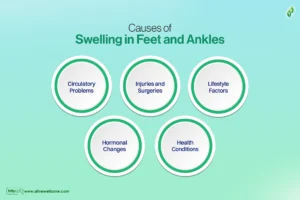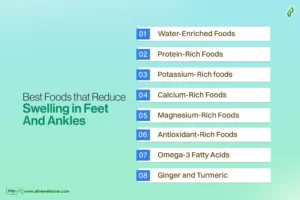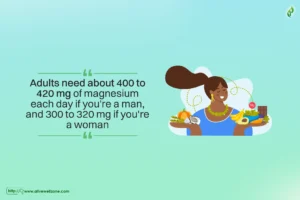Last Updated on November 8, 2024 by Helena Akter
Swollen feet and ankles can be a real pain. Whether it’s after a long day on your feet or the discomfort of long flights, you must find relief. In that case, surprisingly, there are foods that reduce swelling in feet and ankles.
Consider swapping salty snacks for watermelon, oranges, cucumbers, strawberries, and protein-rich options like chicken, fish, and eggs. Plus, potassium-rich foods like bananas and lentils can also help. In addition, eat berries, kale, and omega-3 rich fishes like salmon and tuna.
You’ll also get to know about the foods that you must avoid to prevent swollen feet. We’ll introduce a few lifestyle adjustments and home remedies so that you can get yourself overall protection.
Key Takeaways
- Causes of Feet Swelling: Swelling in feet and ankles (edema) can be caused by various factors, including circulatory problems, injuries, lifestyle factors, hormonal changes, and certain health conditions.
- Foods to Reduce Swelling: Eat foods include water-rich fruits and vegetables, protein-rich foods, and potassium-rich foods. Also, include calcium-rich foods, magnesium-rich foods, antioxidant-rich foods, and foods rich in omega-3 fatty acids.
- Lifestyle Changes: Practice exercise, wear supportive shoes, and try to raise your feet. Plus, maintain a healthy weight, and avoid prolonged sitting or standing.
Causes of Swelling in Feet and Ankles
Swollen feet, ankles, or legs can be annoying and sometimes worrying. This puffiness is often called edema. There are many reasons why this happens. Let’s break it down.

Circulatory Problems
When your blood doesn’t move around your body properly, your feet and ankles might swell up. It can happen for several reasons.
- Sometimes, the veins in your legs have trouble sending blood back to your heart. It can cause swelling, especially if you have varicose veins.
- A blood clot in your leg can block blood flow, making your leg swell up.
Injuries and Surgeries
Getting hurt or having surgery can make the area swollen. For instance —
- If you injure your foot, leg, or ankle, it might swell.
- Operations on your legs, pelvis, or feet can often cause swelling afterward.
Lifestyle Factors
Some things you do or how you live can lead to puffy feet and ankles.
- Spending long periods sitting (like in a car or a plane) or standing can make your feet and ankles swell.
- As you get older or if you’re overweight, you’re more likely to have swollen feet and ankles. If you’re feeling a bit heavy, pick the best weight loss program to stay fit.
Hormonal Changes
Hormones in your body can change the amount of fluid you hold. For example —
- Women’s bodies go through hormone changes during their period or when taking birth control pills. This can cause swelling.
- Many pregnant women’s ankles and feet swell. If the swelling is really bad, it could be a sign of a serious problem called pre-eclampsia.
Health Conditions
Certain health problems and medications can make you retain water, such as —
- Swelling can be a sign of trouble with your heart, kidneys, or liver. These organs help control the amount of fluid in your body.
- Some medicines can cause swelling. These include antidepressants, blood pressure pills (calcium channel blockers), steroids, and certain hormones.
Best Foods that Reduce Swelling in Feet And Ankles
Swollen feet and ankles can be really uncomfortable. Sometimes, it’s because your body is holding onto too much water. Luckily, certain foods can help. Eating these can help your body get rid of extra water and feel better.

1. Water-Enriched Foods
One of the best ways to stop your feet from swelling is to drink lots of water. Believe it or not, some foods are mostly water!
Eating these foods that help with swollen feet can help keep your body hydrated and reduce puffiness.
- Watermelon: This juicy fruit is super refreshing and 92% water.
- Spinach: This green leafy veggie is packed with goodness and 91% water.
- Oranges: Not only tasty, oranges are full of vitamin C and 88% too.
- Cucumbers: Cool and crisp, cucumbers with 96% of water are great for hydrating your body.
- Strawberries: These sweet berries contain 92% water and good things.
So, next time you’re thirsty, try eating one of these instead of sugary drinks.
2. Protein-Rich Foods
Protein does more than just build muscles. It also helps keep your body from getting too puffy. There’s a special kind of protein called albumin that acts like a tiny sponge in your blood. It helps hold water inside your blood vessels.
If you don’t eat enough protein, this sponge can get weak. If that happens, water can leak out of your blood vessels and into your body, causing swelling in your feet, ankles, or legs.
So, if you’re looking for foods to reduce swollen feet and ankles, consider taking the following foods —
- Meat: Chicken, turkey, and lean beef are great sources. An ounce packs about 7 grams of protein.
- Dairy: Milk, cottage cheese, and yogurt are good options. An 8-ounce glass of milk has 8 grams of protein, while ½ cup of cottage cheese has 14 grams. Yogurt can have 12 to 18 grams per 5 ounces.
- Eggs: These are rich in nutrients, including 6 grams of protein each.
- Nuts: Almonds, walnuts, and other nuts are great for protein. A ¼ cup gives you 4 to 6 grams.
- Fish: Tuna is a good choice. One ounce has about 7 grams of protein.
3. Potassium-Rich foods
Potassium is great for your body! It helps control blood pressure and stops you from feeling puffy. It’s because it works against the sodium in salt. In fact, some research indicates that eating more sodium can cause your body to retain more fluid.
So, if you want to create healthy eating habits with the best foods for edema in legs, try eating more foods with potassium like —
- Banana
- Dried apricots
- Lentils
- Acorn squash
- Potatoes
- Kidney beans are good choices.
Moreover, swap sugary drinks for low-fat milk or orange juice to get more potassium. But, if you have health problems, especially kidney issues, talk to your doctor before changing what you eat a lot.
4. Calcium-Rich Foods
Along with potassium, calcium is one of the foods good for swollen ankles. It helps keep your body’s water levels right. Eating foods with calcium in them can help with swelling.
Try adding these to your meals —
- Dairy Foods: Milk, cheese, and yogurt are packed with calcium.
- Green Leafy Veggies: Broccoli, collard green, and kale are good sources of calcium.
- Tahini: This sesame seed paste is a different way to get more calcium.
Keep in mind that calcium and potassium-rich foods also qualify as healthy food for older women.
5. Magnesium-Rich Foods
If you’re experiencing fluid retention, it might be due to a lack of magnesium. This mineral helps your body manage its water levels. To get more magnesium, try eating these foods —
- Almonds
- Cashews
- Spinach
- Legumes
- Potatoes
- Peanut Butter
- Brown Rice
- Raisins
In fact, adults need about 400 to 420 mg of magnesium each day if you’re a man, and 300 to 320 mg if you’re a woman. You can usually get enough from food.

But if you’re worried, talk to a doctor before taking magnesium pills, especially if you have kidney or heart problems.
6. Antioxidant-Rich Foods
Your body sometimes gets hurt by things called free radicals. This can make you swell up. Antioxidants are like superheroes that fight these bad guys. Eating foods with antioxidants can help protect your body and reduce swelling.
Some of the antioxidant foods to reduce swelling in feet are —
- Berries, like blueberries, strawberries, and raspberries, are nutrients packed with these antioxidants. They’re also tasty and colourful!
- Leafy greens like spinach and kale are also amazing for this.
By eating these foods often, you can help your body stay healthy and reduce swelling.
7. Omega-3 Fatty Acids
Omega-3s are special oils that can help your body fight swelling. They’re found in lots of foods, especially fish. These good fats help calm down your body’s reaction to hurt or irritation, which can make your feet feel better.
Here are some foods with lots of omega-3s —
- Salmon
- Mackerel
- Sardines
- Tuna
- Chia Seeds
- Flaxseeds
- Walnuts
Adding these foods to reduce swelling in feet can really increase your foot health. Plus, Omega-3 fatty acids offer a bunch of benefits for your feet, such as —
- Blocking the creation of pro-inflammatory cytokines
- Lowering the levels of adhesion molecules
- Possibly easing the inflammation in swollen feet
8. Ginger and Turmeric
Spice things up with turmeric and ginger! Not only do these spices add a burst of flavour, but they also come with amazing health benefits.
Turmeric contains curcumin, while ginger is rich in gingerol. Both of these compounds are known for their anti-inflammatory properties.
Adding turmeric and ginger to your food can help your body heal and feel better, especially if your feet are swollen. It’s easy to do, but it can help with pain and puffiness.
What Foods to Avoid When You Have Swollen Feet
If your feet puffy, maybe what you eat is making it worse. Some foods can make your feet swell, especially if you’re sensitive to them.

Pasta and Bread
They’re made with white flour, which can make you puffy for some people. It’s even worse if you can’t eat gluten. Gluten can make your body inflamed, and that might be why your feet are swollen.
So, try not eating gluten for a while and see if your feet feel better. Meanwhile, watch how your body reacts and change what you eat if you need to.
Juice
Juice can be good for you, but most store-bought kinds have lots of extra sugar. This sugar is bad for your body and can make you puffy, just like soda. Plus, always check the label on juice to see if it has too much sugar. Choose juices without extra sweet stuff to help your feet feel better.
So, choosing natural juices without added sugars can help you avoid foods that cause swelling in feet and ankles.
Soda
Too much sugar makes your body inflamed. In fact, they can make your feet and ankles puffy. According to the Dietary Guidelines for Americans, you should keep your sugar intake under 10% of your daily calories.

It means, for a diet of 2,000 calories, that’s less than 200 calories from sugar. All-in-all, try to drink less soda or none at all to help with swelling.
Reduce Sodium (Salt) Intake.
Eating too much salt can make your body hold onto extra water. Hence, spice up your food with herbs like thyme, oregano, and rosemary instead of using salt.
Besides, The Dietary Guidelines for Americans say you shouldn’t eat more than 2,300 milligrams of salt each day.
Speaking of salt, we must meet you with the Deli meat. It’s a sneaky way salt can sneak into your diet, especially in sandwiches. Moreover, a normal sandwich can have a lot of salt in the meat, cheese, and bread.
To eat less salt, try low-sodium cold cuts, tempeh, tofu, or eggs in your sandwiches.
Skip the Processed Food
Processed foods and those that come in packages often have lots of salt and bad fats. These can make you swell up. Fried foods are also trouble because they’re high in salt and unhealthy fats that cause inflammation.
And inflammation can lead to swelling!
Cut Back on Caffeine
Caffeine can make you pee more, but it often comes with sugar and carbs. These can dry you out. Therefore, your body might hold onto water, making you swell up.
That’s why, try drinking less coffee, tea, and soda to help with this.
Complementary Lifestyle Adjustments to Foods That Reduce Swelling in Feet
What you do is just as important as what you eat when it comes to puffy feet.
Get Moving
Moving around helps a lot. Try things like —
- Walking
- Yoga
- Gentle stretches
These help your body move fluid away from your feet.
Wear the Right Shoes
Your shoes matter too. Look for ones that —
- Are flat
- Feel good
- Are wide in the front
- Have extra room
- Have straps to help
Take Care of Your Feet
Other things that can help —
- Wearing tight socks
- Putting your feet up
- Losing weight if you need to
- Not standing or sitting too long
All of these can help your feet feel better.
What is the Best Home Remedy for Swelling Feet?
Here are some things you can do at home to help your feet feel better —
- Lie down and put your feet up on pillows so they’re higher than your heart.
- Exercise helps push extra water back into your heart. It can help stop your body from holding onto too much water.
- Relax in a cool Epsom salt bath for 15 to 20 minutes.
- A lymphatic drainage massage can help reduce swelling by gently moving lymph fluid around your body.
- Fill a bucket or shallow pan with cold or room-temperature tonic water and soak your feet for at least 30 minutes.
- If you’re traveling, get up and walk around often.
- Avoid tight clothes around your thighs.
- You can try compression socks if you have lymphedema-related swelling.
- Shedding extra pounds can help.
When to Call Your Doctor if You Have Swelling?
Call your doctor if your feet get really bad and —
- You have open sores
- Your feet hurt more
- You see blisters, red spots, or oozy stuff
- Your feet are swollen on just one side
Also, watch out for your shoes. Tight shoes can rub against your skin and cause sores. Tight shoes also stop blood from flowing well, which makes the swelling worse.
If only one foot is swollen, see your doctor right away. You could have a blood clot in your leg.
Final Words
To wrap it up, we’ve shown you the foods that reduce swelling in feet and ankles. These include water-rich fruits and vegetables, and protein-rich sources like lean meats and fish.
Plus, add those foods that are rich in potassium, calcium, and magnesium. Also, you have that Omega-3 fatty acids and antioxidants can also play a role.
Remember, lifestyle changes like exercise and managing salt intake are just as important. If you’re experiencing significant swelling, consult a doctor to rule out underlying conditions.
FAQs
What is the main cause of swollen feet?
It’s hard to pinpoint one thing that causes swollen feet. You can get it from constant standing, pregnancy, excessive sitting, obesity, and getting older.
What Is Edema?
Edema is swelling caused by fluid buildup in the body’s tissues. You can often notice it in your hands, feet, arms, legs, and ankles.
How can I reduce swelling in my feet fast?
You can reduce swelling in your feet quickly by drinking water, walking, and lifting your feet. Also, you can wear compression socks, and avoid salty foods.
Do bananas help swollen feet?
Yes, bananas are good for reducing swelling in feet. That’s because they help maintain proper electrolyte balance and provide vitamin B6. It supports your nerve and skin health.
What home remedy can you use to soak your swollen feet?
You can use Epsom salt to soak your swollen feet. That’s because the magnesium in Epsom salt may help reduce swelling and inflammation.
What to eat to reduce swelling while pregnant?
You can eat foods rich in vital vitamins and minerals to help reduce swelling while pregnant. Natural diuretics like watermelon, cucumbers, and celery can aid in managing fluid retention.

